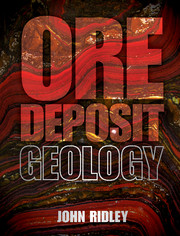Book contents
- Frontmatter
- Contents
- List of boxes
- Preface
- Acknowledgements
- 1 What is an ore deposit?
- 2 Magmatic ore deposits
- 3 Hydrothermal ore deposits I: magmatic and orogenic environments
- 4 Hydrothermal ore deposits II: sedimentary environments
- 5 Ore deposits formed in sedimentary environments
- 6 Supergene ores and supergene overprinting of ores
- Glossary
- References
- Index
- References
5 - Ore deposits formed in sedimentary environments
- Frontmatter
- Contents
- List of boxes
- Preface
- Acknowledgements
- 1 What is an ore deposit?
- 2 Magmatic ore deposits
- 3 Hydrothermal ore deposits I: magmatic and orogenic environments
- 4 Hydrothermal ore deposits II: sedimentary environments
- 5 Ore deposits formed in sedimentary environments
- 6 Supergene ores and supergene overprinting of ores
- Glossary
- References
- Index
- References
Summary
Ore deposits form in sedimentary environments as a result of one of two generalised geological processes: either as a result of mineral precipitation from solution in surface waters, most commonly from sea water or lake waters; or as a result of physical accumulation of ore minerals during processes of sediment entrainment, transport and deposition. The theoretical backgrounds to ore formation through each of these two processes are discussed separately followed by detailed descriptions of some important deposit types formed through each process.
Chemical precipitation from surface waters (hydrogene deposits)
Compositions of surface waters and ore mineral precipitation
A chemical sedimentary ore is one in which the concentration of ore minerals accumulated as a result of precipitation from solutions at the Earth’s surface. All natural surface waters are multi-element solutions. Average seawater contains about 3.5 wt % salts, comprising of order weight per cent levels of Na and Cl, and tens to hundreds of ppm of a number of elements of economic interest (Figure 5.1).
- Type
- Chapter
- Information
- Ore Deposit Geology , pp. 290 - 336Publisher: Cambridge University PressPrint publication year: 2013



